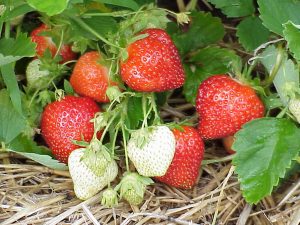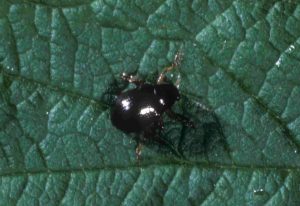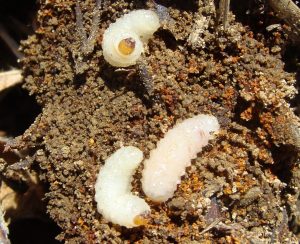Strawberry IPM Newsletter No. 4 – June 14, 2019

Strawberry IPM Newsletter No. 4 – June 14, 2019
Click on photos to enlarge.
TARNISHED PLANT BUGS IN SOUTHERN FIELDS
Two-Spotted Spider Mite and Fungal Disease Threat Remains
Situation:
Aside from a warm, nearly dry weekend, we have mostly seen a continuation of the persistent cool, wet weather, pushing harvest dates back further in the already late season. A few berries may be picked this weekend in southern Maine from fields that were under row covers. However, many fields still have later varieties that are still in bloom. Temperatures are predicted to come up a bit this week and there is no threat of frost. Many growers are now applying fungicides for protection against gray mold. Once spray materials have dried on the plants, they are generally considered “rainfast”, unless there is more than one inch of rainfall. should more than one inch of rain occur following a spray, or there has been significant shoot or flower growth since the last application, another fungicide application should be applied to assure adequate protection.
Strawberry bud weevil or “clipper”: Early fields in southern Maine are now beyond the bloom-fruit development stage where clipper can cause significant damage. However, later blooming fields should still be monitored for clipper injury until most of the flower buds have opened. Clipper injury was found above the control threshold in two fields scouted this week, and we should expect activity to increase as temperatures warm, if flower buds are still available.
Tarnished plant bug activity has been increasing in some fields this week. Both adults and nymphs were more widespread around southern and some coastal sites, but only one field was found to be over the control threshold of more than 4 flower clusters out of 30 sampled being infested. Nymph populations may increase rapidly with warmer, drier conditions, and pose a threat throughout the bloom and early fruit development period.
- Third Instar Tarnished Plant Bug Nymph; photo by David Handley
- Strawberry Rootworm Beetle; photo by James Dill
Strawberry rootworm (not root weevil) adults and feeding injury have been found on strawberry leaves in some fields this week. The adult stage of this insect is a small (1/8”) dark brown beetle. The beetles feed on strawberry leaves during the spring and late summer, causing numerous small holes in the leaves. The adults in fields now will soon lay eggs. The larvae are small grubs that feed on the roots of strawberry plants, causing them to be stunted and weak. If these beetles and/or feeding injury is prevalent in a field, a treatment is recommended. Sevin 50WP® is registered for control of this pest. Sprays can be timed to also control strawberry bud weevil. Strawberry rootworm should not be confused with root weevil, a larger insect that generally causes much more serious damage when present in a field.
- Black Vine Weevil; photo by David Handley
- Strawberry Root Weevil Grub; photo by David Handley
Black vine weevil & strawberry root weevil: As harvest season approaches, black vine weevils and strawberry root weevils will begin to emerge and start feeding on strawberry foliage. Look for notching along the leaf edges and the presence of the black or brown snout beetles. The weevils feed mostly at night and spend the daylight hours at the base of the plants under the mulch. They lay eggs during the harvest and post-harvest period. The larvae, or grubs, feed on the strawberry plant roots through the fall, overwinter deep in the soil and feed again in the spring, causing plants to weaken and die. Badly infested beds should be plowed up as soon after harvest as possible. Bifenthrin (Brigade®) can be applied to kill the adults when they emerge and start to feed on the leaves (usually until mid-late July). Applications should be made at night when the insects are active, and the highest rate of the insecticide should be used. Platinum® can be applied in the fall as a soil drench to control grubs before they go into the winter.
Two-spotted spider mites: We found spider mites on leaves in some fields this week, but mostly in very low numbers, and none that were over the control threshold of 25% infestation. It is important to keep scouting for mites as the season progresses. Their numbers can increase rapidly under warmer conditions.
Cyclamen mites: We have seen some light symptoms of cyclamen mite injury over the past two weeks, but haven’t found any live mites yet, probably because the cool, wet weather is causing them to stay well hidden. Heavily infested plants show weak growth and shrunken, crinkled leaves. These mites are very small and reside in the crown of the strawberry plant, feeding on the developing leaves and flower buds. They are very hard to see, even with magnification. Portal® can be effective, but must be applied in lots of water to be sure that the material is carried down into the crowns where these mites reside.

Leaf spot continues to be found on susceptible varieties this week, but mostly on older foliage. The cool, damp weather has encouraged this problem. Fungicides now being applied for gray mold, including captan, Luna Sensation®, Mervion® and Pristine®, will also provide control of leaf spot.
The 2019-2020 edition of the New England Small Fruit Management Guide is now available.
If you would like to purchase a copy please contact Pam St. Peter at pamela.stpeter@maine.edu or the Highmoor Farm address below. Copies are $15 each. Members of the Maine Vegetable and Small Fruit Growers Association (MVSFGA) or the New England Vegetable and Berry Growers Association will receive free copies of the guide. For MVSFGA membership information, contact Bill Jordan at 207.799.1040. You can also access the guide on the UMass Cooperative Extension website.

Save the Date – Highmoor Farm Field Day 7/31/19
The Highmoor Farm Field Day will offer an evening program and tours on Wednesday, July 31st. More information will be available soon. We hope you can join us!
Sincerely,
David T. Handley
Vegetable and Small Fruit Specialist
Highmoor Farm UMaine Extension Diagnostic
P.O. Box 179 Research Lab, Pest Mgmt. Unit
52 U.S. Route 202 17 Godfrey Drive
Monmouth, ME 04259 Orono, ME 04473
207.933.2100 1.800.287.0279
The University of Maine is an equal opportunity/ affirmative action institution.
Where brand names or company names are used, it is for the reader’s information. No endorsement is implied nor is any discrimination intended against other products with similar ingredients. Always consult product labels for rates, application instructions and safety precautions. Users of these products assume all associated risks.




